Continuing with Native American Heritage Month, and as a reminder that Native American doesn’t only mean in the United States, we revisit our trip to Chichén-Itzá from a few years ago.

Having been to Tulum several years ago, we knew that our return to the Yucatán had to include another visit to one of the many Mayan historic sites on the peninsula.
Chichén-Itzá was our first choice, since it is certainly one of the most impressive of those ancient cities, and as Viator Ambassadors we were able to join their Early Access to Chichén-Itzá with a Private Archaeologist tour from Cancun.

By heading out at dawn we were able to beat most of the crowds and heat.
Our archaeologist guide, Frank, used the travel time to explain the history of the site, the Maya people, and what we were about to see.
A huge part of that history is held within the architecture.

By studying the engraved writings and precise alignments of the buildings archaeologists have uncovered a wealth of information about the people who built them.
As Frank described things, he promised blown minds, which we took as a challenge… go ahead, Frank, make our day.
He showed us examples of the Mayan written language, the only one in the Americas at that time, and their advanced numeric system based on twenty.
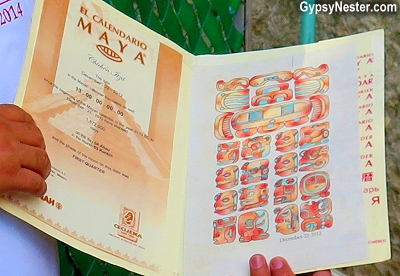
Their mathematical theory, one of only two in the world that incorporated the concept of zero, was as precise as any on the planet, as was their famous calendar.
All very impressive stuff, the kind that gets people talking about aliens helping out and the like.
But we would need to see more if our heads were going to explode.


Arriving at the site, what we saw of Chichén-Itzá was only the central area, the downtown if you will, of what was once a thriving city of over fifty-thousand people.
The focal point was the pyramid temple of the feathered serpent Kukulkan, built to honor one of the Mayans’ most important gods.

The pyramid that the Spaniards mistakenly called El Castillo was already some five centuries old when they arrived in 1532, and the city had been mostly abandoned.
We now know it was a temple, not a castle, and it holds a few surprising secrets. The four sides are perfectly aligned with the directions, and Frank explained how the entire structure served as a calendar.
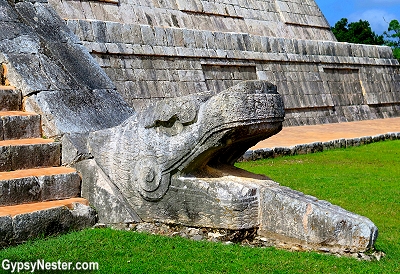
There are ninety-one steps on each side, for a total of 364.
Adding the one at the top makes it 365, as in the days in a year.
The stairs are also designed so that on the spring and autumn equinoxes the sun casts a shadow that forms a serpent descending to connect with the carved stone heads of Kukulkan at the base.

Standing in front of the staircase Frank demonstrated another remarkable feature of the pyramid, some amazing acoustics were incorporated.
First he played us a recording of the call of a quetzal, the bird whose feathers adorn the serpent, then sharply clapped his hands. The sound that echoed back to us was identical.
Watch: David demonstrates this phenomenon
As we stood in awe he said, “That may be a coincidence, but I doubt it.” We spent a few moments trying to wrap our minds around that, but our craniums remained intact.

At the base of the giant structure excavations reveal an incredible feat of engineering.
The foundations for the pyramid extend hundreds of feet out from the base, and even more impressive, the entire central area was built up and leveled out into an artificial plateau to create an acceptable building location for the massive temples and ball court.
Extraordinary stone work to be sure, but not as mind boggling as the work of the Incas, so our brains endured.
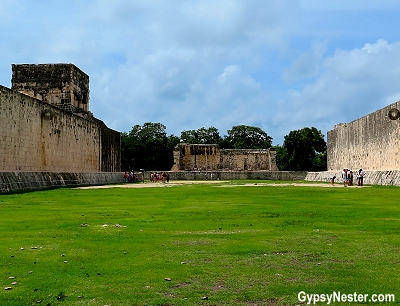
The Great Ball Court is the largest, and best preserved, to be found throughout Mesoamerica.
The game, or something similar, was played all across the region in highly ceremonial situations.
Two teams of four players vied to put a nine pound solid rubber ball through a stone ring about twenty feet high, without using their hands or feet.

It sounds difficult, because it was.
Massive bruises, injuries, and even deaths were a common occurrence, but often that was only expediting the inevitable, because the winners were sacrificed anyway.
Yes, the winners, which probably blew their minds, but the rulers just couldn’t go around offering up losers to the gods.

This was not a spectator sport for the masses, which is why the court lacks any grandstand style seating.
The opposing rulers would sit on opposite ends of the stadium, which is nearly the size of two football fields, with a small group of dignitaries.
The court also gave Frank a chance to further prove the Mayan understanding of acoustics.

There should have been no way for the rulers to communicate across that distance, yet the court’s designers solved the problem.
When Frank spoke into the seating area on one end, we could hear the echo bouncing back all the way from the other. The shape of the royal boxes made it possible for the leaders to easily converse.
Very impressive, but still our minds remained whole.

After checking out several other incredible structures in the central area, such as The Platform of Venus (named for the planet, not the Roman goddess), The Tzompantli (Skull Platform), The Temple of the Warriors, and the Group of a Thousand Columns, we made our way down a sacbe to The Cenote Sagrado.


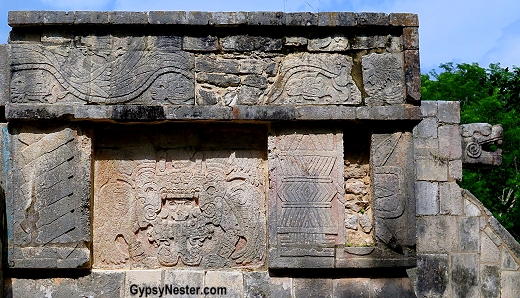




A sacbe is a raised road, paved with crushed rock, and the Mayans built hundreds of miles of them all across the peninsula.
The design was so durable that they are still easily recognizable today, in fact, many are still in use, incorporated into the right of ways of modern highways and railways.
Very sturdy, just like our minds.


The Cenote Sagrado, or Sacred Cenote, is an enormous sinkhole filled with fresh water.
These holes are very common in the Yucatán because the ground is solid limestone, which dissolves away leaving caves and holes that fill with rain water.

The city took its name, Chichén, in reference to the two cenotes, or wells, that the city was built around. Itzá, refers to the people who lived there.
But as precious as water was, the Sacred Cenote was not used as a water supply. It was a hallowed place of sacrifices to the rain god Chaac, who was believed to live at the bottom.
This was proven by the discovery of many bones and offerings when divers explored its depths.



We moved on for a look at another group of slightly older ruins just off from the main area.
These feature the Nunnery and the Church, also misnamed by the Spanish because of their appearances. Las Monjas, the Nunnery, actually served as a governmental palace, La Iglesia, the Church, was a more nearly correct name since it was a small temple.



Nearby, El Caracol, towers above the other ruins.
The name means the snail, and stems from the shell-like spiral staircase inside, but research revealed that the structure was actually a sophisticated astronomical observatory.

Remarkable calculations, mostly based on the 584-day cycle of the planet Venus, were involved in designing the windows along the stairs so that they line up perfectly with over two dozen cosmic events such as eclipses, equinoxes, and solstices.
The theories and mathematics involved have been compared to those of Newton or Einstein.
Okay… minds blown.
(To tell the truth, they really were blown from the moment we spotted the pyramid)
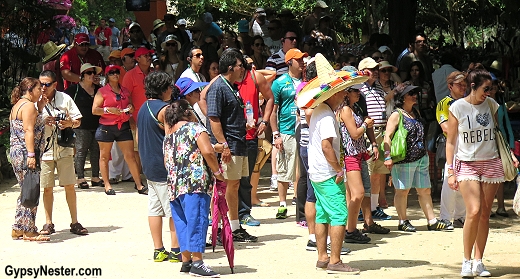

David & Veronica, GypsyNester.com
See all of our adventures in Mexico!
We are proud to be Viator Ambassadors – big thanks to Viator for providing this mind-blowing adventure! As always, all opinions are our own. To see more about this tour, click here.



It is an amazing post and you explained it in a detailed way. Nice to see this here. I will bookmark your blog for more details. Keep sharing new things like this.
It’s been a while since I visited Chichén-Itzá. Thanks for your detailed reminder about what an astonishing place it is!
Our pleasure Carole!
Amazing. I really enjoyed visiting Tulum. I’ll have to add Chichén-Itzá for next time I’m in that area of Mexico.
Thanks Donna! Definitely.
Fun times with the Gypsy Nesters! Love the last photo – so you! The others are really beautiful too – thank you!
Thanks Suzanne!
Sorry to say, but Chichen Itza is probably the most disappointing Mayan ruin site in all of Mexico. Overrun by bus loads of tourists (Cancun is just too close), commercialised, drastic restrictions on everything (which I can understand with the crowds visiting) – just no fun! I visited once in 1989 and it was a little better, but I still prefer Uxmal or Yaxchilan…
That’s why it was so important to us to beat the crowds on our tour – we were among the first to arrive and it had turned to mayhem as we were leaving!
Believe me: last time we visited we were really early because we camped in our RV nearby. Instead half the site was blocked off for some weird photo shoot. These guys were allowed to lean heavy equipment cases right against old stone carvings, complained if you walked into their ‘frames’, had big boxes and gallows for cameras and lights everywhere, noisy generators, cables laying everywhere… I felt cheated for my entrance fee!
Easy to see how that could sour your experience.
I’ll echo Michele’s comment about how much the right guide can contribute to the visitor experience. To have an archeologist who is passionate and knowledgeable about this site take you around must have felt absolutely priceless. Loved all the details about the acoustics and linear architecture/astrology.
Certainly helped us to learn much more about the site and the Maya people.
I’m with Suzanne on my butt 🙂 Going up was okay, but coming down was scary! 🙂
Incredible- thanks for the blow by blow. I’ve been to Altun Ha in Belize, and would love to see Chichen Itza as well. But Machu Picchu blew MY mind (I know, Inca, not Maya, but pretty amazing.)
Agreed Sarah.
Fascinating tour, loved all the history and stories you shared with us today.
Great photos and congrats on the new gig!
xo
The Mayan civilisation has always fasciated me and your photos show that I won’t be disappointed when I finally get to visit. What an incredible eat to build the temples with so many advanced features. Fascinating!
You sure won’t be disappointed Jenny.
It sounds as though it’s really worthwhile to get a guide like Frank when visiting Chichen Itza. Ive been there many times but never knew about the site’s special acoustics. How brilliant to have done a demo using the call of the quetzal, the symbol of the Maya and national currency of Guatemala.
It was very worthwhile Michele.
We’ve visited several of the ruins (Tulum, Uxmal, Ek Balam …) located around the Yucatan Peninsula over the years and Chichen Itza is amazing just for the vastness of the site not to mention the astonishing architecture throughout. I remember clapping near El Castillo and how the sound reverberated. I agree -Minds Blown!
Most definitely! We would love to visit more of the sites across the area.
I really beat the crowds. My first visit to Chichen Itza was on a college study trip in January of 1975. (Yep. I’m that old). Cancun had not yet been built. The Mexican Minister of Tourism showed us the plans for it. At that time, you could still climb el Castillo. It was quite steep. I remember coming back down the stairs on my butt, holding onto a chain.
David got to see it back then too. Stayed on Isla Mujeres before it was all built up too. Wasn’t it great?